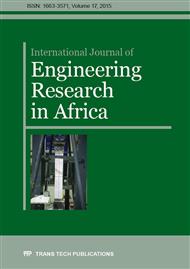[1]
A. G. Marinopoulos, M. C. Alexiadis, & P.S. Dokopoulos, 'Energy losses in a distribution line with distributed generation based on stochastic power flow',. Electric Power Systems Research, 81(10), p.1986.
DOI: 10.1016/j.epsr.2011.06.006
Google Scholar
[2]
O. S. Ohunakin, 'Energy utilization and renewable energy sources in Nigeria', Journal of Engineering and Applied Sciences, vol 5, issue 2, p.171–177, (2010).
Google Scholar
[3]
O. S. Ohunakin, 'Wind resource evaluation in six selected high altitude locations in Nigeria',. Renewable Energy, vol36, issue 12, p.3273–3281, 2011. doi: 10. 1016/j. renene. 2011. 04. 026.
DOI: 10.1016/j.renene.2011.04.026
Google Scholar
[4]
K. Ajao, O. Oladosu, & O. Popoola, 'Using HOMER power optimization software for cost benefit analysis of Hybrid-solar power generation relative to utility cost in Nigeria',. International Journal of Research and reviews in Applied Sciences, vol7, issue 1, pp.96-102, (2011).
DOI: 10.4314/jast.v16i1-2.64779
Google Scholar
[5]
N. Jenkins, J. Ekanayake, & G. Strbac, 'Distributed Generation',. The Institution of Engineering and Technology, Michael Faraday House, Six Hills Way, Stevenage SG1 2AY, UK. 2010. doi: 10. 1049/PBRN001E.
DOI: 10.1017/s0001924000011672
Google Scholar
[6]
J. Olamaei, T. Niknam, & M. Nayeripour, 'Effect of Distributed Generators on the Optimal Operation of Distribution Networks',. International Science Index, Vol. 2, p.599–603, (2008).
Google Scholar
[7]
M. M. Elnashar, R. El Shatshat, & M. M. A. Salama, 'Optimum siting and sizing of a large distributed generator in a mesh connected system',. Electric Power Systems Research, vol. 80, issue 6, p.690–697, 2010. doi: 10. 1016/j. epsr. 2009. 10. 034.
DOI: 10.1016/j.epsr.2009.10.034
Google Scholar
[8]
J. A. P. Lopes, N. Hatziargyriou, J. Mutale, P. Djapic, & N. Jenkins, 'Integrating distributed generation into electric power systems: A review of drivers, challenges and opportunities',. Electric Power Systems Research, vol. 77, issue 9, p.1189.
DOI: 10.1016/j.epsr.2006.08.016
Google Scholar
[9]
P. Chiradeja, & R. Ramakumar, 'An Approach to Quantify the Technical Benefits of Distributed Generation', IEEE Transactions on Energy Conversion, vol. 19, issue 4, p.764–773, (2004).
DOI: 10.1109/tec.2004.827704
Google Scholar
[10]
H. Kuang, S. Li, & Z. Wu, 'Discussion on advantages and disadvantages of distributed generation connected to the grid',. International Conference on Electrical and Control Engineering, p.170–173, 2011. doi: 10. 1109/ICECENG. 2011. 6057500.
DOI: 10.1109/iceceng.2011.6057500
Google Scholar
[11]
T. Ackermann, G. Andersson, & LSöder, 'Distributed generation: a definition. Electric Power Systems Research', vol. 57, issue 3, p.195–204, 2001. doi: 10. 1016/S0378-7796(01)00101-8.
DOI: 10.1016/s0378-7796(01)00101-8
Google Scholar
[12]
Y. Wang, F. Ronilaya, X. Chen, & A. P. Roskilly, 'Modelling and simulation of a distributed power generation system with energy storage to meet dynamic household electricity demand',. Applied Thermal Engineering, vol. 50, issue 1, p.523.
DOI: 10.1016/j.applthermaleng.2012.08.014
Google Scholar
[13]
F. Ding, P. Li, B. Huang, F. Gao, C. Ding, & C. Wang, 'Modeling and Simulation of Grid-connected Hybrid Photovoltaic / Battery Distributed Generation System',. China International Conference on Electricity Distribution, pp.1-9, (2010).
Google Scholar
[14]
B. O. Bilal, V. Sambou, P. A. Ndiaye, C. M. F. Kébé, & M. Ndongo, 'Study of the Influence of Load Profile Variation on the Optimal Sizing of a Standalone Hybrid PV/Wind/Battery/Diesel System',. Energy Procedia, 36, 1265–1275, 2013. doi: 10. 1016/j. egypro. 2013. 07. 143.
DOI: 10.1016/j.egypro.2013.07.143
Google Scholar
[15]
J. Dekker, M. Nthontho, S. Chowdhury, & S. P. Chowdhury, 'Economic analysis of PV/diesel hybrid power systems in different climatic zones of South Africa',. International Journal of Electrical Power & Energy Systems, vol. 40, issue 1, p.104.
DOI: 10.1016/j.ijepes.2012.02.010
Google Scholar
[16]
P. Nema, R. K. Nema, & S. Rangnekar, 'A current and future state of art development of hybrid energy system using wind and PV-solar: A review',. Renewable and Sustainable Energy Reviews, vol. 13, issue 8, p.2096.
DOI: 10.1016/j.rser.2008.10.006
Google Scholar
[17]
R. Dufo-López, & J. L. Bernal-Agustín, 'Multi-objective design of PV–wind–diesel–hydrogen–battery systems',. Renewable Energy, vol. 33, issue 12, p.2559–2572, 2008. doi: 10. 1016/j. renene. 2008. 02. 027.
DOI: 10.1016/j.renene.2008.02.027
Google Scholar
[18]
A.A. Bazmi, & G. Zahedi, 'Sustainable energy systems: Role of optimization modeling techniques in power generation and supply—A review',. Renewable and Sustainable Energy Reviews, vol. 15, issue 8, p.3480.
DOI: 10.1016/j.rser.2011.05.003
Google Scholar
[19]
Y. A. Katsigiannis, & P. S. Georgilakis, 'Optimal sizing of small isolated hybrid power systems using tabu search',. Journal of Optoelectronics and Advanced Materials, vol. 10, issue 5, pp.1241-1245, (2008).
Google Scholar
[20]
US Department of Commerce, 'Biomass Energy Data Book. Bureau of Economic Anlysis', 2011. http: /www. bea. gov/iTable/iTable. cfm, ReqID=5&step=1#reqid=5&step=4&isuri=1&411=2004&412=1&401=1&402=1&403=1&413=7VA, 71VA, 711ASVA, 713VA.
Google Scholar
[21]
P. Brinckerhoff, 'Thermal Power Station Advice - Reciprocating Engines Study', November, (2009).
Google Scholar
[22]
DiracDelta Science and Engineering Encyclopedia. [online] available from http: /www. diracdelta. co. uk/science/source/s/p/specific%20fuel%20consumption/source. html#. VVTFJJM3lAP Accessed (13/05/15).
Google Scholar
[23]
M. S. Adaramola, S. S. Paul, & O. M. Oyewola, 'Assessment of decentralized hybrid PV solar-diesel power system for applications in Northern part of Nigeria',. Energy for Sustainable Development, vol. 19, 72–82. doi: 10. 1016/j. esd. 2013. 12. 007.
DOI: 10.1016/j.esd.2013.12.007
Google Scholar


